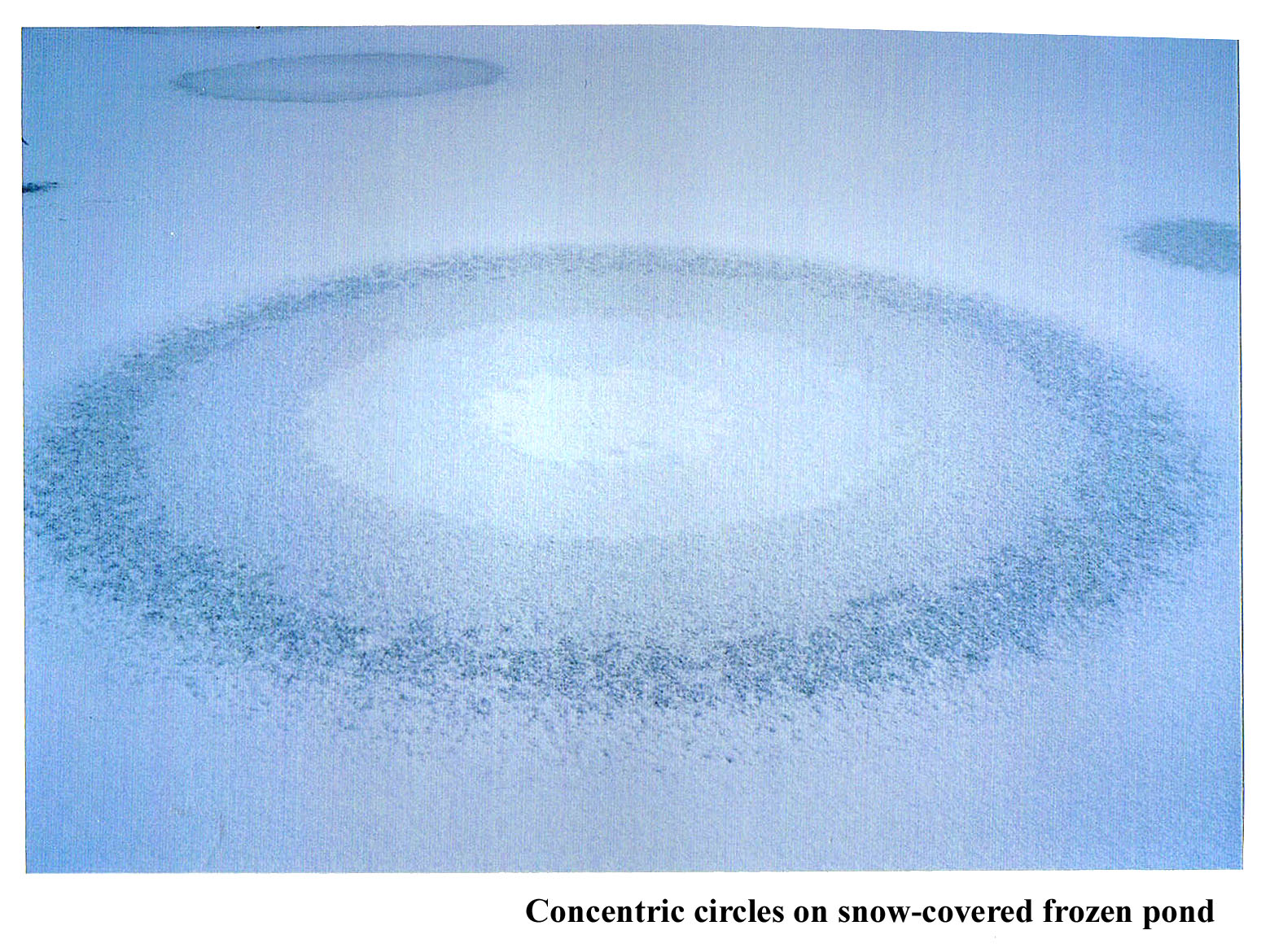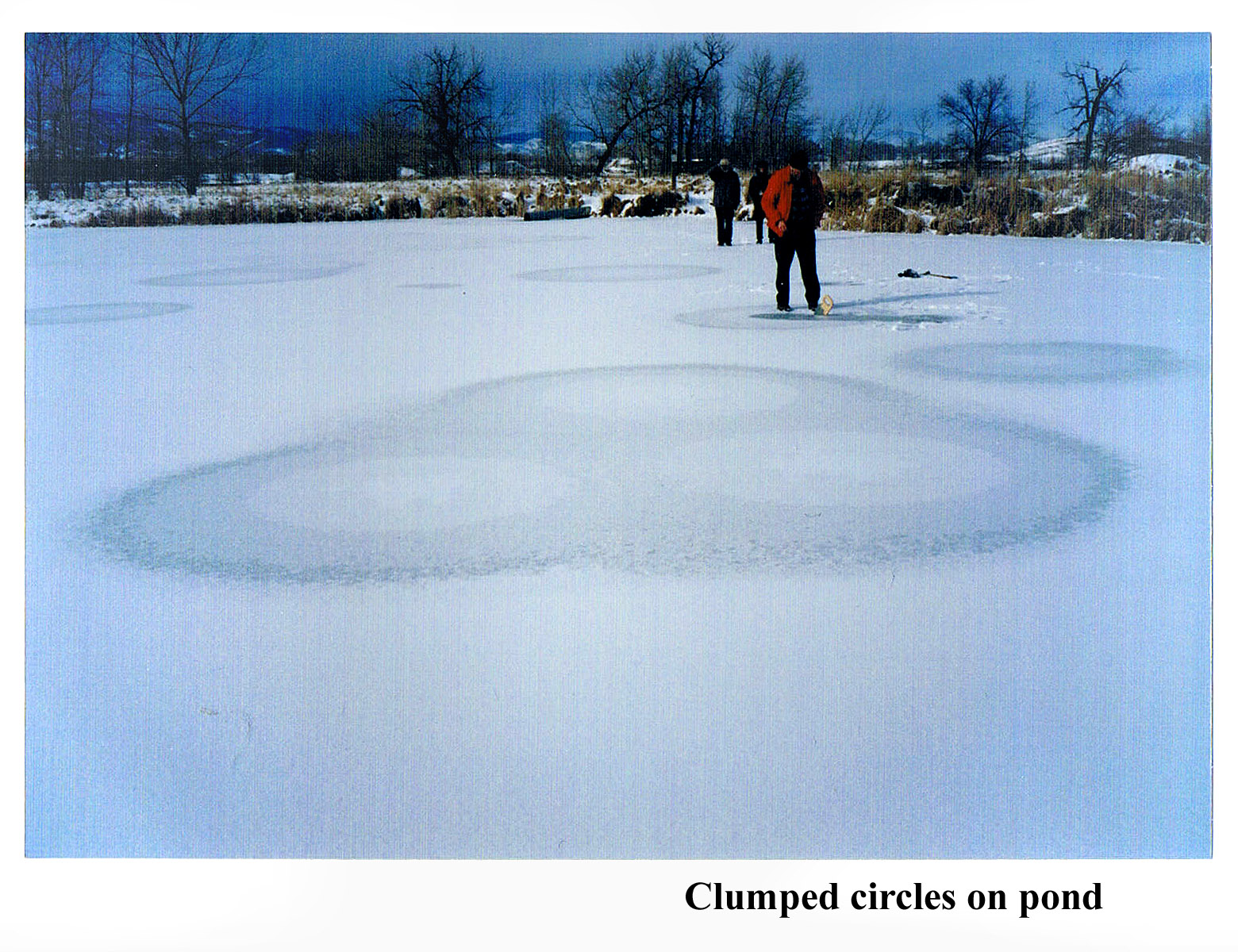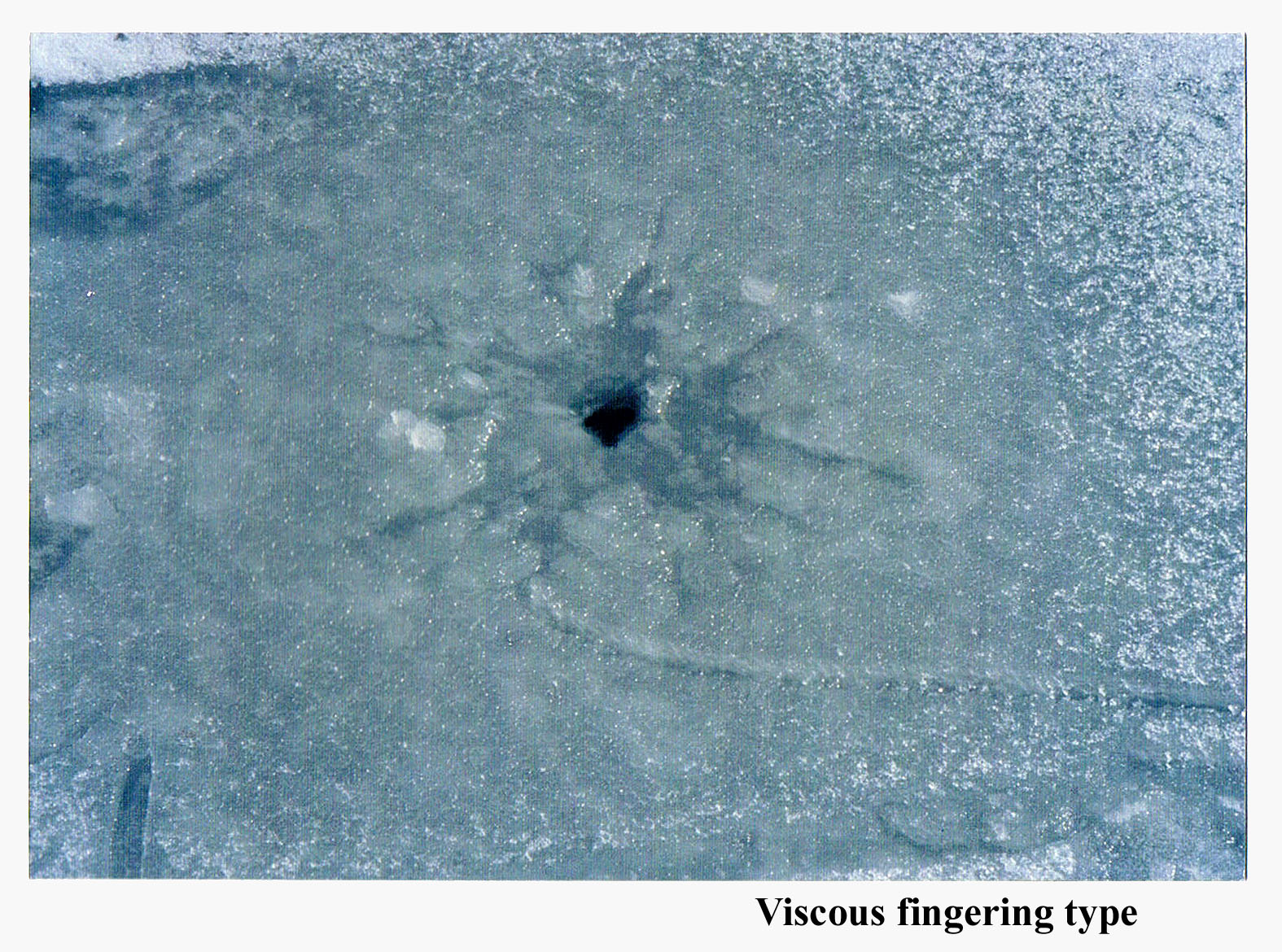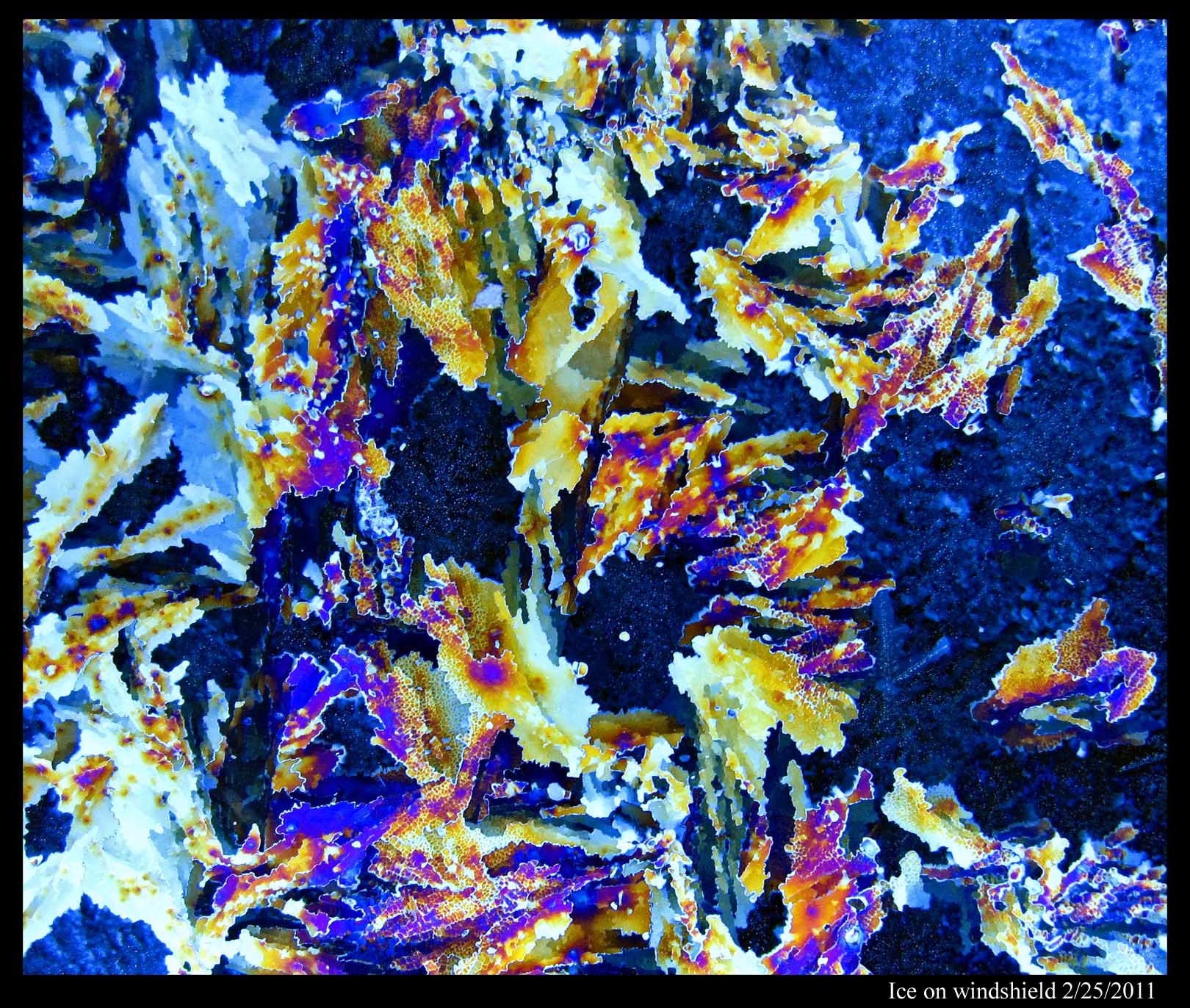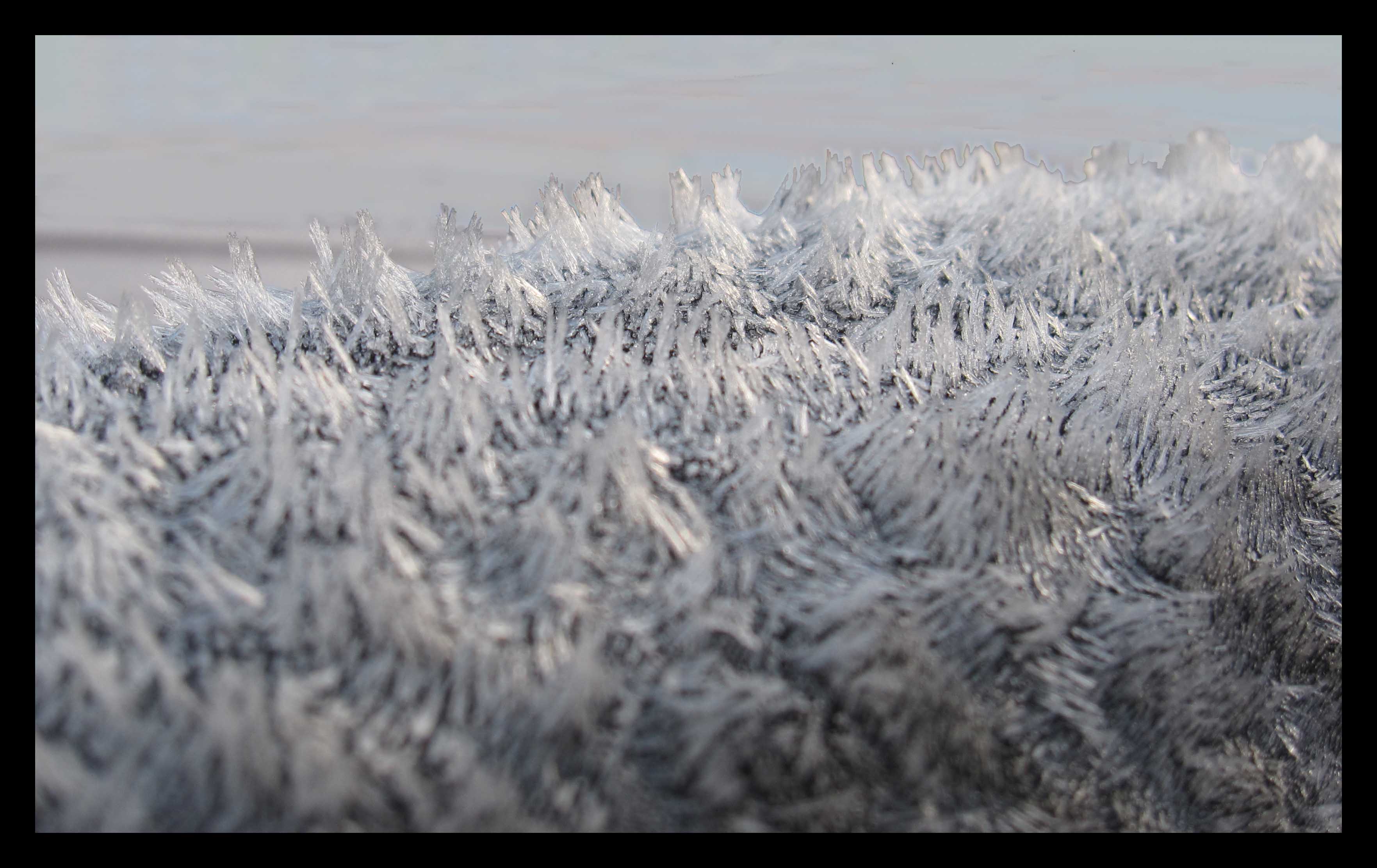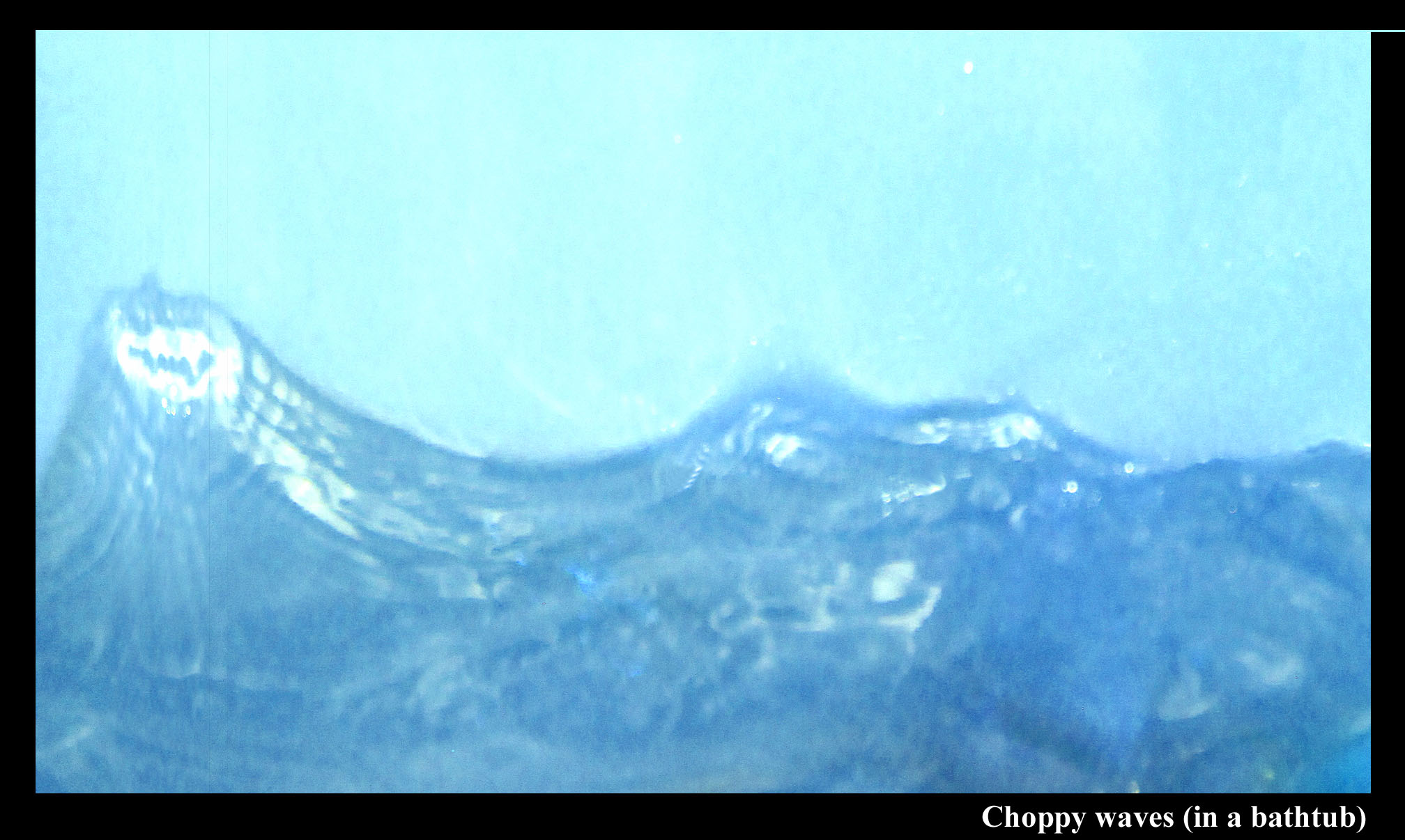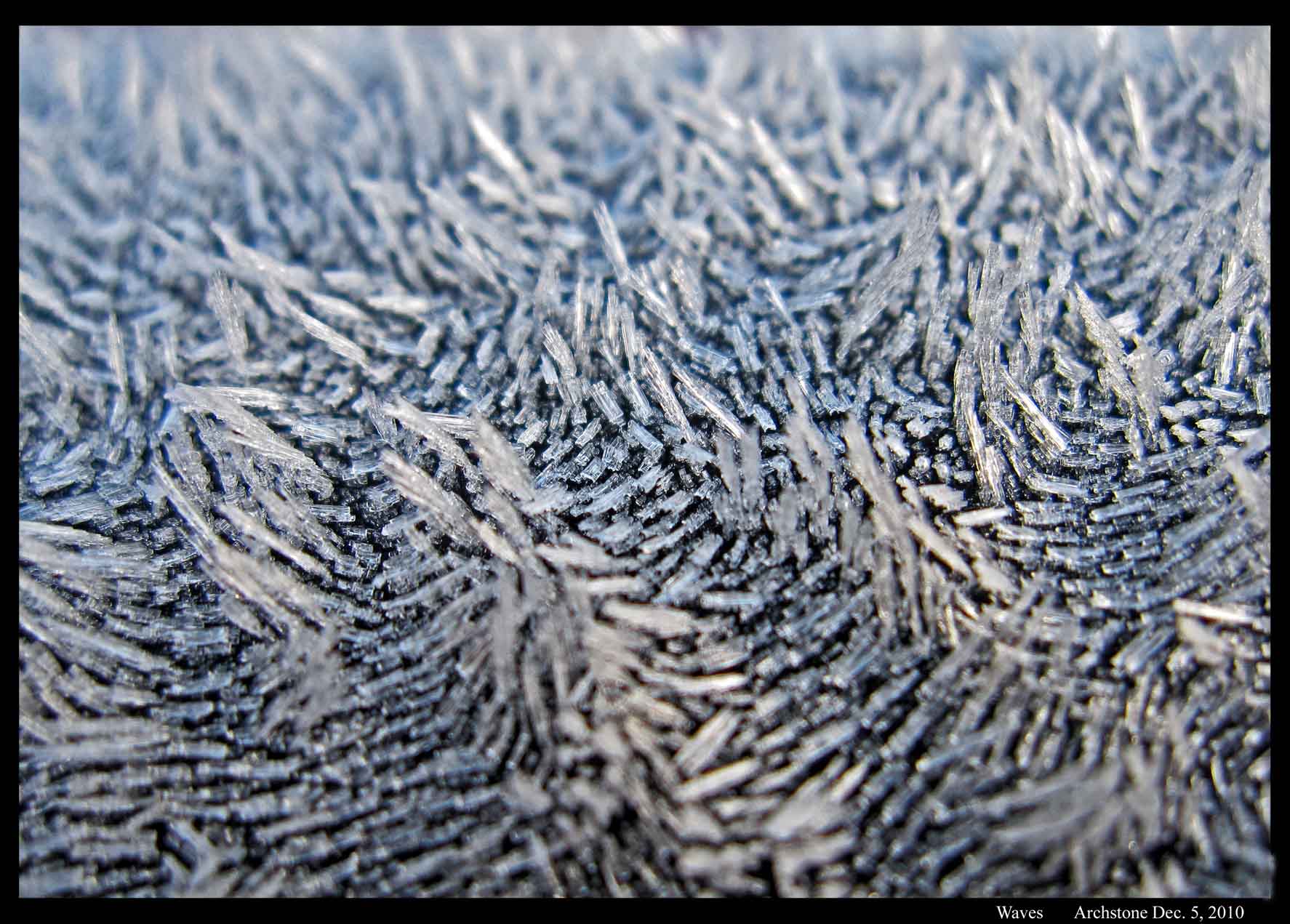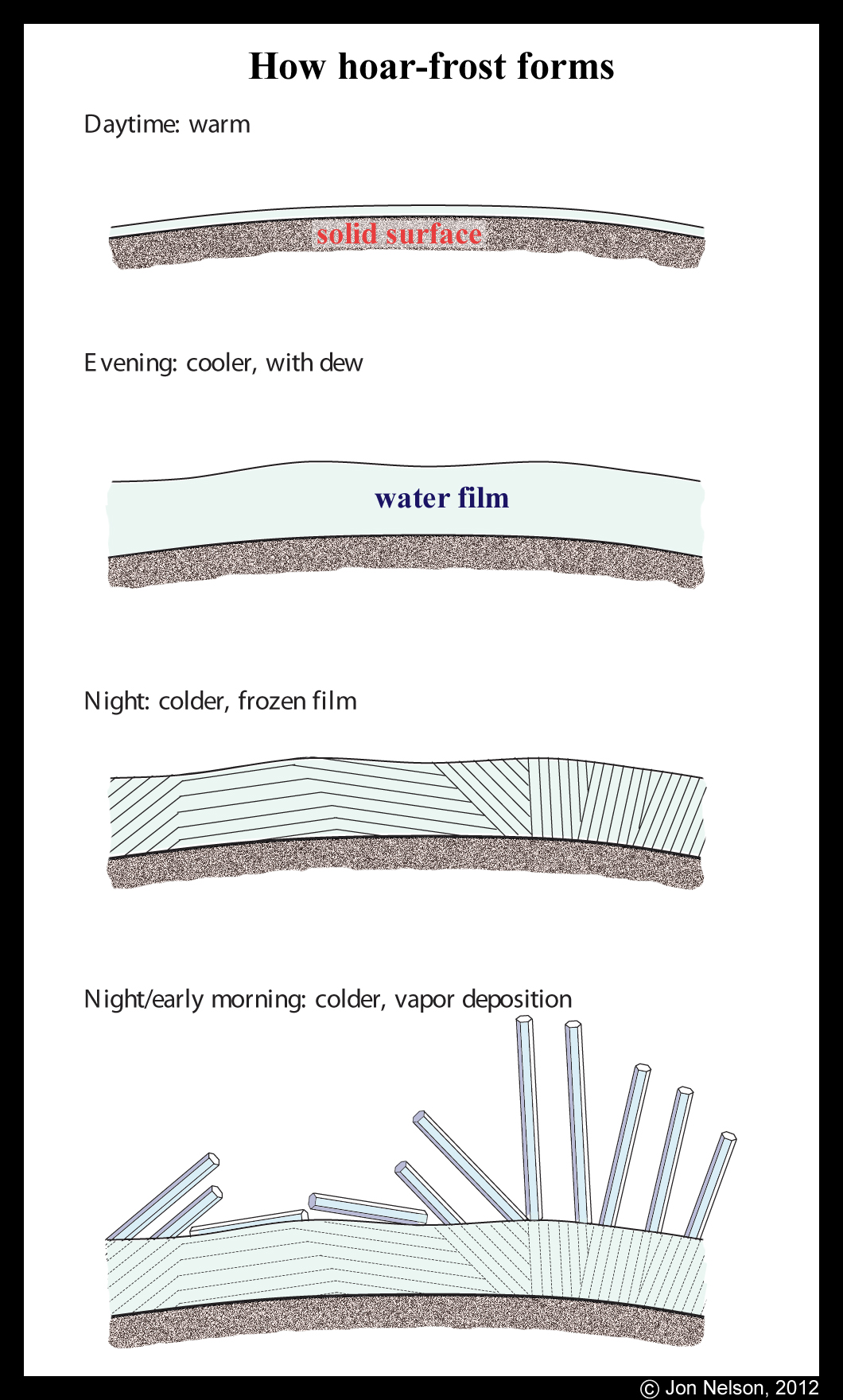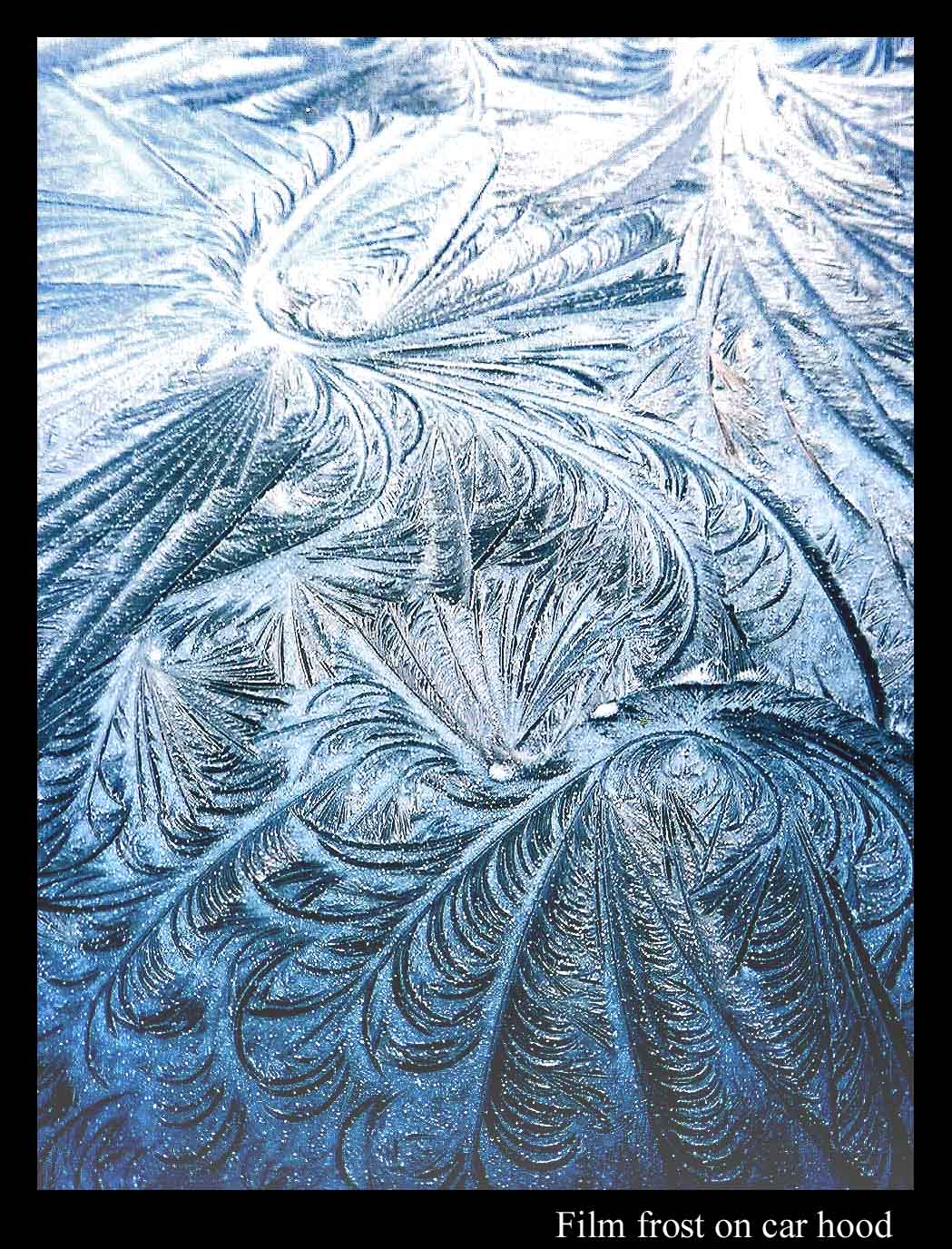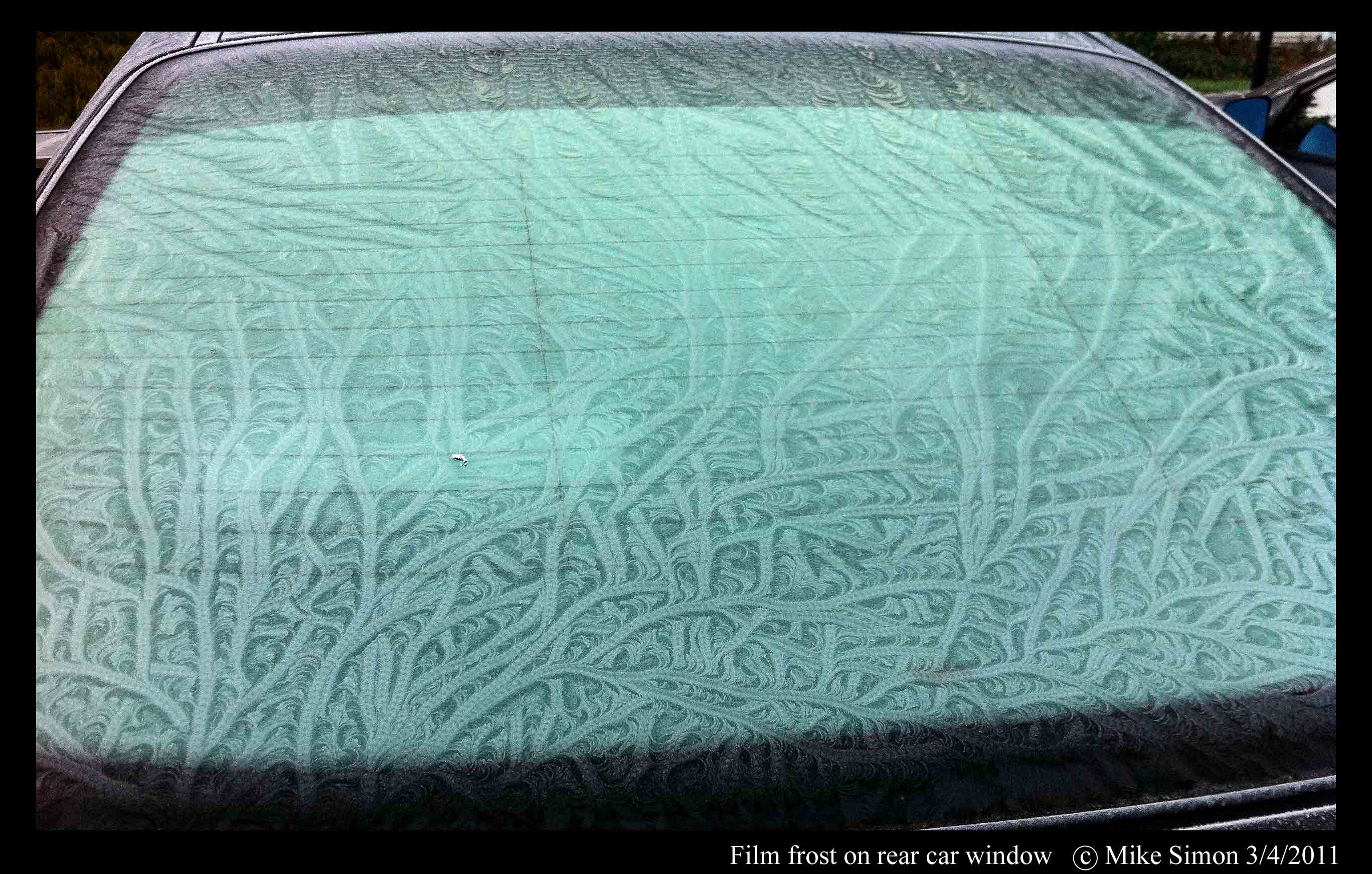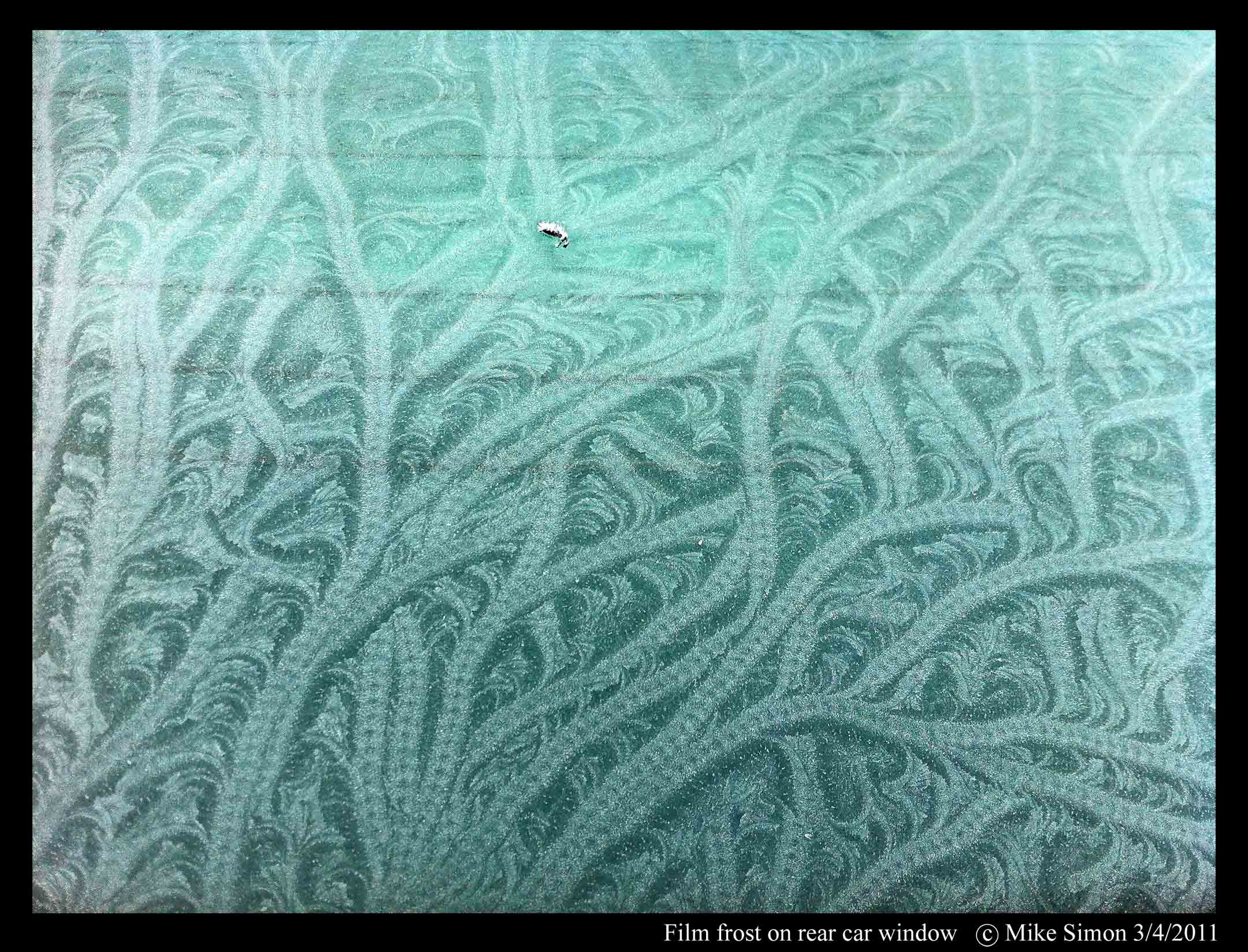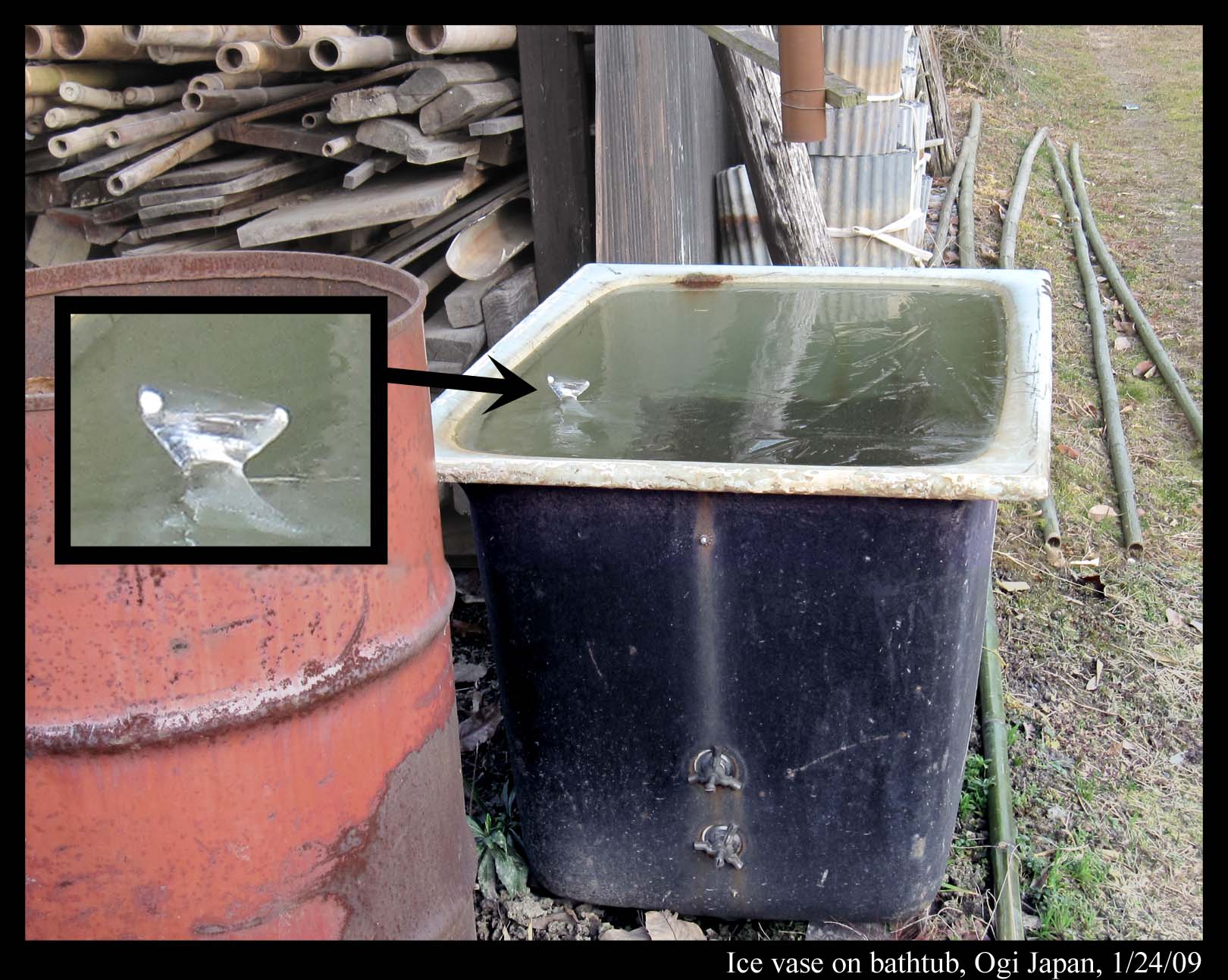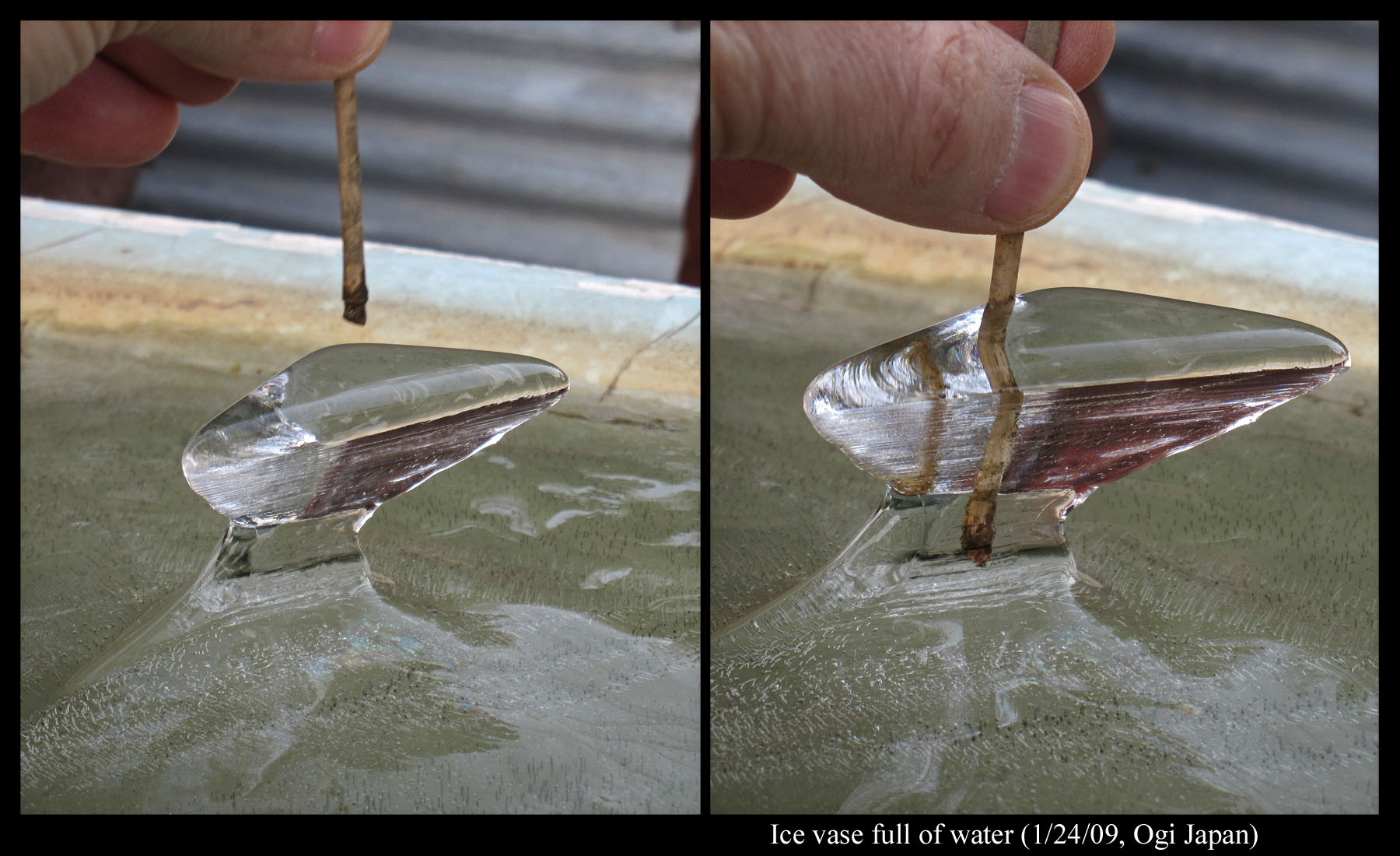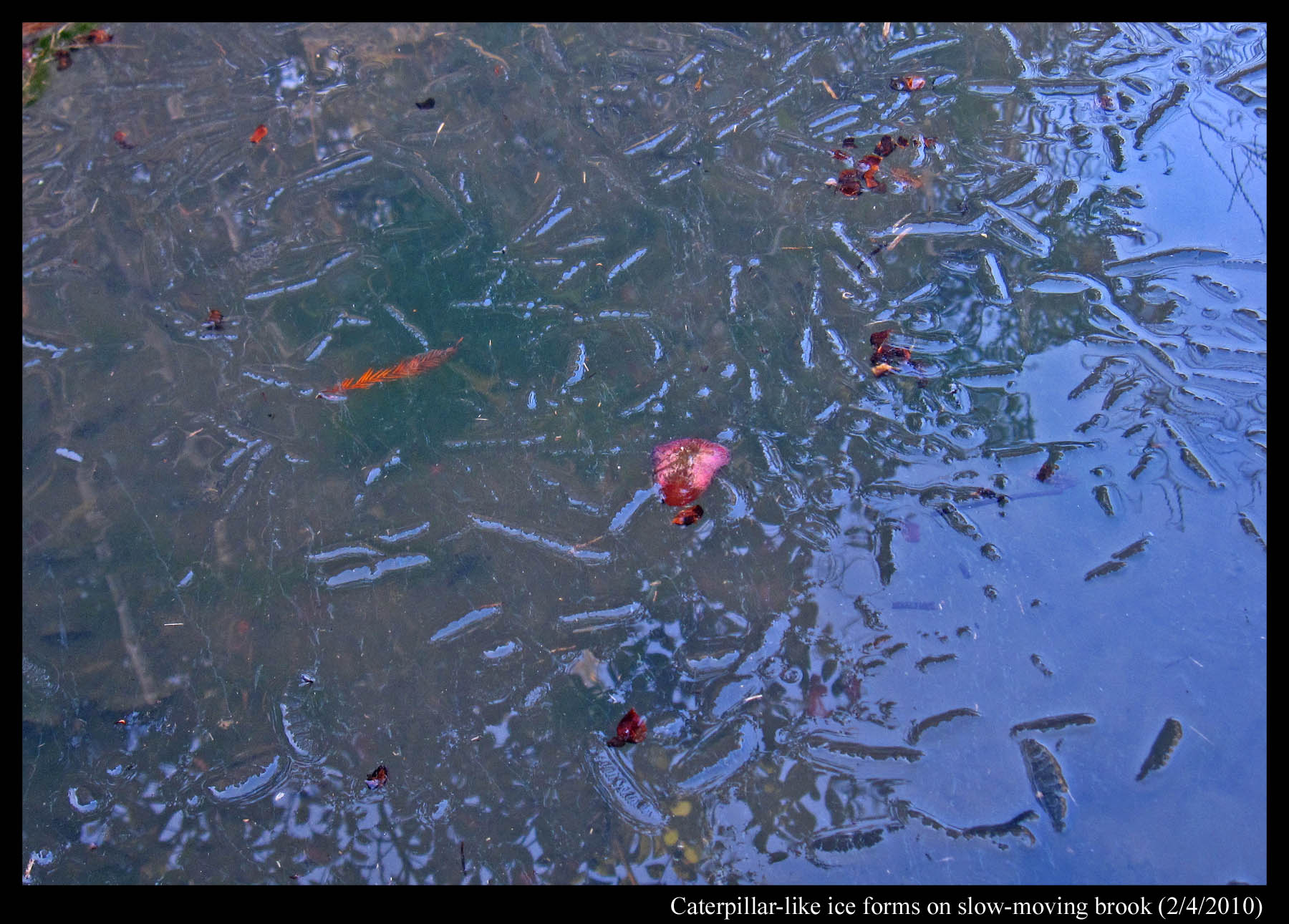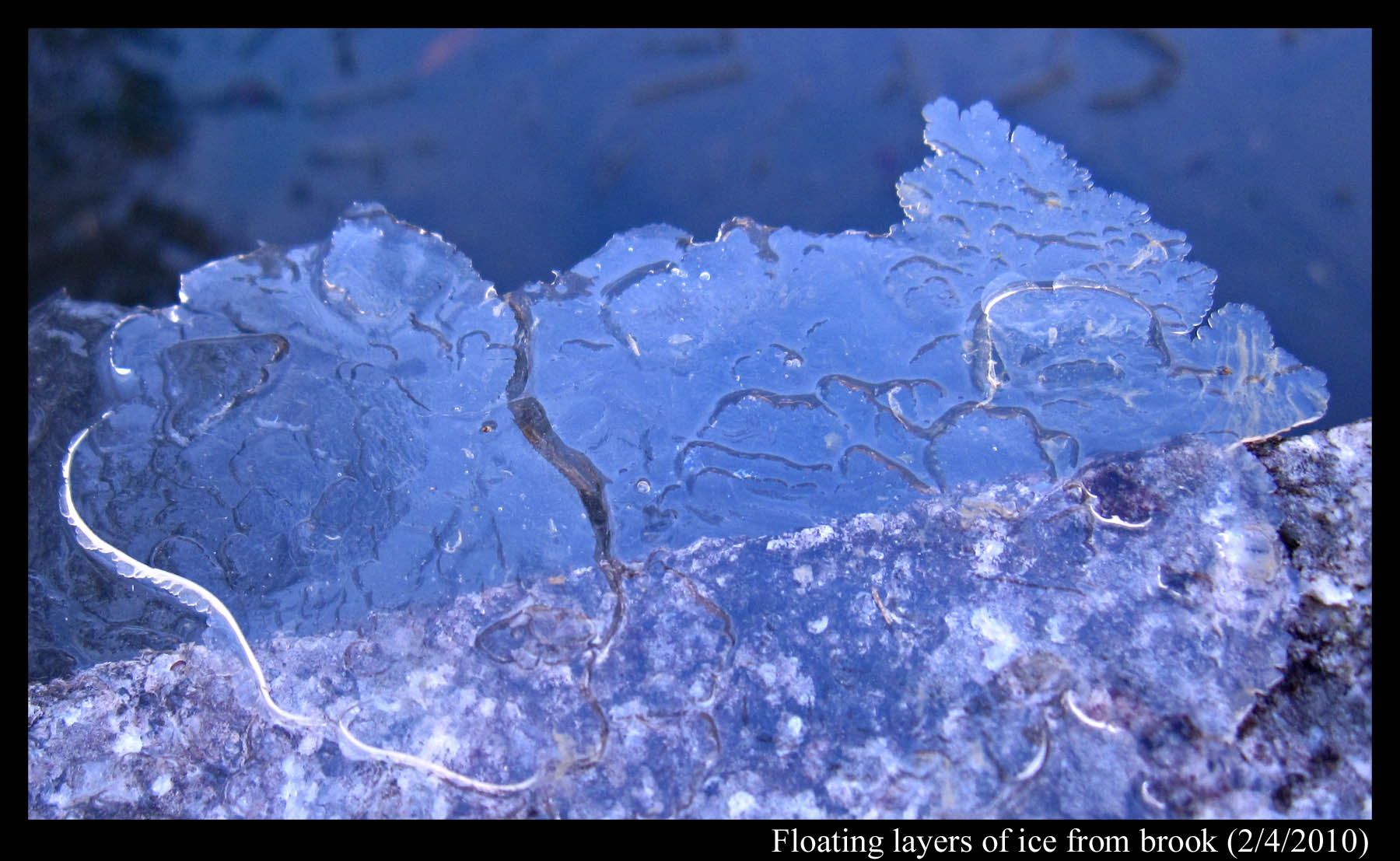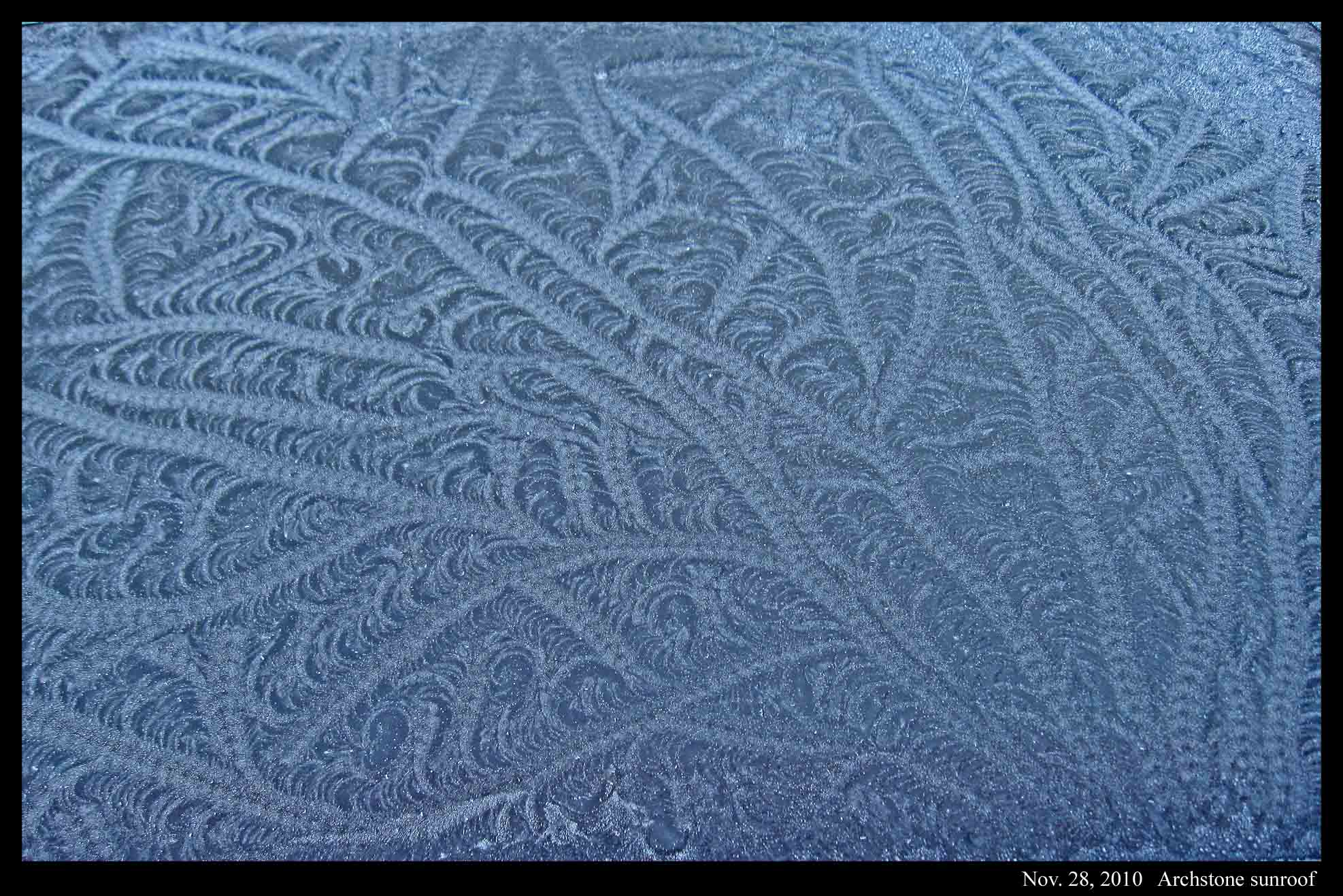Category: "Photos"
Snow on a Freshly Frozen Pond
January 15th, 2012Back when I was doing post-doctoral work in Boulder, Colorado, Charlie Knight, the head of my lab, introduced me to strange ice phenomena. The most memorable one happened after the weather had been sub-zero for a few days and then we got some snow. When this happened, we stopped work and drove out to some shallow ponds to look at the patterns on the surface. Sometimes odd, concentric circles formed.
To see the size of the rings, check out the overview.
The guy in the background is Charlie. He is sawing through the ice to get a sample. Behind him are two visitors who came out with us that day. The ice was about 2" thick, if I remember right, and would make some cracking noises sometimes as we walked on it.
I don't know if he figured out the cause of the pattern. I never made any progress in understanding it. Anyway, what seems to happen is that water gets pushed out through a small hole in the ice, and the water apparently spreads out in a circular region. But why does the lightness of the ice change in nearly equally spaced, discrete steps? And why is it whitest in the center?
I figured that if water flooded over the ice in discrete steps (day-night temperature fluctuations, as we think happens with the pancake ice?), then the region in the center would be the darkest, not the whitest. For example look at this counterexample.
This shows the hole where water comes out, but the water floods outward in a ragged fashion, not like a concentric circle. This type of flow has been studied a lot in the laboratory and has the technical name "viscous fingering". Anyway, notice that the region near the center is darker, not whiter.
Any ideas about the concentric circles?
--Jon
Fun with windshield ice
January 11th, 2012In my last post, I pointed out that you can determine the crystal orientation in a film of ice by looking at hoar-frost that sprouts from its surface. Here's another way, but it only works if the ice is on glass. For example, here's ice on my windshield, as seen through crossed polaroids:
To get colors, the ice must be sufficiently thick. You can play around by spraying a mist of water onto your windshield (or some other sufficiently cold pane of glass), letting it freeze, looking through the polaroid sheets, and then spraying some more if you don't see colors you like. One polaroid sheet must be in front of the ice, the other behind the ice. And you need to cross the sheets. You can tell when the sheets are crossed because a bare pane of glass will be black between crossed polaroids.
Two things determine the color: the thickness of the ice and the crystal orientation. So, the boundary between different colors marks the boundary between different crystals. Black regions usually mark regions where the crystal is "basal" orientation; that is, you are viewing the ice crystal lattice from the same angle that you are viewing the nice dendrite crystals that Mark posts here. And where the color changes gradually, you are seeing where the ice thickness is changing gradually.
Of course, don't try this while driving!
-- Jon
Choppy waves
January 11th, 2012I thought this hoar frost pattern looked like rough seas. I see choppy, cusp-like waves down there.
Not having any pictures of rough seas, I hopped in our bathtub and kicked my legs around to make waves. Perhaps you can see a little resemblance.
However, the processes that caused the cusp-like, choppy wave pattern in the frost are completely different from those in the bathtub. Look more closely at the hoar-frost pattern:
It just goes to show you that hoar frost is never as simple as you’d think. Though from a distance it might look like white whiskers, up close it shows unexpected patterns. These patterns reveal something about how the crystals strained, twisted, and competed with each other.
Though it is true that the hoar crystals we see are built of deposited vapor molecules (invisible water molecules once floating in the air that happened to strike and freeze onto a cold surface), the story of hoar has an earlier beginning. In the beginning, the surface already had a thin film of liquid water. See the top panel in the sketch below.
What We Sometimes Miss
March 8th, 2011For the first few years in which I would excitedly go out on frosty mornings to photograph ice formations, I never paid any attention to frost on car bodies. Sometimes I would notice something on our car window, but that was basically it – I was essentially blind to ice in places where I didn’t expect to see anything interesting. Then one day, while returning from an area that often had fascinating puddles and ground ice, I walked next to a black car with the most stunning display of frost that I had ever seen. The car was completely covered roof, hood, and trunk with a thick, large, curvy white pattern of ice made distinct by the background of black underneath.
I spent the next hour or so taking pictures, returning home once to get another camera when my roll of film ran out. Though I understood roughly the processes involved, the initial freezing of a thin layer of water, making curvy ice patterns, followed by vapor depositing onto the frozen parts as hoar, making the ice white, there were other puzzling things that kept me entertained. However, the most puzzling thing of all was the fact that people would walk right by without even slowing down. Here was a strange and rare sight: strange because of the hastily dressed man (myself) leaning over a parked car with a tripod snapping pictures, and a rare yet striking display of curving frost in full view, and yet they paid me nor my prize no mind. It was as if I was the only person who could see the pattern.
The reverse thing happened to me just a few days ago. We had wet weather one day followed by a cold, clear night – perfect conditions for good hoary film frost. And indeed, many cars in our parking lot had beautiful curvy film-frost. I walked around, looking specifically for black cars, which show the most contrast to the white hoar, and photographed some on one car, but somehow overlooked the most amazing one of all: a speckled-seaweed-like pattern that I've seen only once before (see the Dec. 1 posting).
Even though the above was on a black car in a region I checked, I still missed it. But luckily, my neighbor caught it and emailed a few photos. In the image, some of the trails seem to cross over each other, but closer inspection instead suggests a coincidental merging of two trails on one side with a forking off on the other side.
An Ice Vase Sprouts From a Bathtub
February 6th, 2011Someone recently sent me a beautiful image of an ice structure in the shape of a vase. The vase in that case had somehow sprouted out of a frozen birdbath. The thing reminded me of an ice vase I once found on an old plugged-up bathtub in a farmer’s field in Japan. See the photo below.
On approaching the tub, I first thought the ice bump on top was some chunk that had fallen off the roof and refrozen. But on closer view, I found that the thing had sprouted out of the surface. How did I know? Well, as I leaned over it, my body pressed against the tub wall, and I noticed something move. Turned out it was water on top, filling up the vase to the brim! See the sequence below.
Clearly, I’m not pushing that flimsy twig through solid ice.
Of all the curious things I’ve seen here, never before nor since did I see something like this water-filled ice vase. However, the vase forms in much the same way as the somewhat-more-common “ice-cube spikes” that sprout from ice cube trays. But how do such spikes and vases form?
Ice Forms on Slow-moving Water I: Caterpillars and Cellular Dendrites
January 15th, 2011During my last winter in Japan (2009-2010), I would walk around a neighborhood park on frosty mornings, looking for interesting ice forms. It was in this park that I found one rock (only one!) that on some mornings would sprout hair-like ice, arising from liquid water within (see the last images in my “Ice on the Rocks” post, Jan 27). This park also has a small, slow-flowing brook that, despite the relatively warm conditions, often freezes over. Usually, upon freezing, it shows an ice pattern consisting of many long (~ one foot) straight lines – a typical pattern you usually see on glaciated puddles and ponds. But on the morning of February 4, at one spot right before the water tumbled over a waterfall, the ice surface looked slightly different. It had lines, but the lines were short, thick, and bumpy (see photo below), looking a bit like black-blue caterpillars scattered about.
From the small bridge spanning the brook, I reached down, pulled some ice out, and was shocked at what I saw. This was not “solid” ice, but rather a bunch of very thin ice plates loosely resting on each other – somewhat like a deck of cards spread out in a fan, though in this case, each ice plate had its own size and shape. Also, unlike other thin ice plates I’d seen before, these ones resembled neither the fast-growing ice dendrites (the snow-crystal-like, branched forms) nor the slow-growing ice discs. The photo below also shows that the plates were big – the section shown being several inches across.
Over larger streams and faster-moving water, ice can develop into something called frazil ice. I’ve no experience with frazil ice, never having lived in a cold-enough region, but I this caterpillar ice may be different. For one, the water was extremely slow-flowing. I could not discern the flow, even in ice-free regions, whereas the descriptions I’ve read about frazil ice involve easily discernable flow rates, flow rates that introduce turbulence, crystal collisions, and mixing below the surface. Also, the ice crystals I saw were much larger than the millimeter-sized pieces I see reported for frazil ice. So, the caterpillar form might be a transitional form, between frazil and that over stagnant water.
More Tales of Mystery and Observation
December 1st, 2010When I stepped out early Saturday morning, the air seemed relatively warm, particularly compared to the cold snap we had last week. Indeed, it was much warmer, and yet the parking lot in our apartment complex had a glaze that was much more dangerous than that during the cold snap.
But it was the frost that I noticed. Of course, the air was relatively warm, but the clear sky cooled the surface. Recently, snow melted, leaving plenty of open water to evaporate – perfect conditions for film frost and hoar.
I saw “striped-tail” film frost(1) on two car roofs, both times on the sunroof glass. Why only on the glass? Perhaps the glass, being a poorer conductor of heat, had a lower surface temperature. This lower temperature would have produced a thicker film of water, and the thickness of the film seems to influence the pattern. The bigger mystery though is the cause of the pattern. In a short online article(2) last year, I suggested a cause for the stripes on each tail, though I can offer no explanation for either the nearly uniform width of the tails or the meandering. In the case below, the pattern is dense with lazily wandering striped tails. When I look at it, I think of seaweed. The metal car surfaces often had nice curving film-frost with dense hoar, while others had or condensed droplets with more isolated, spiky hoar. The latter appeared on my own car.
BEDFISH: Revising an old Idea for Classifying Surface Ice Forms
January 31st, 2010It often seems like people refer to any kind of ice stuck on something as frost. If one looks in books or the Internet, one can usually find a specific term for the many different and interesting ice formations, but a term used by one group of people generally differs from that used by another. Wouldn’t it be nice for scientists and naturalists (at least) to have some generally universal, agreed-upon way to describe any surface-ice formation? Snow crystals have such a system, so why not surface-ice forms?
We could try to establish word-names for each formation, like “frost flower”, but different people are used to using different names for the same thing, and they are unlikely to give up the habit, particularly if they are unfamiliar with the language of the term’s origin. For example, there are several well-used terms for the ice columns in dirt that I discuss in “Ice on the Rocks” including “frost heave”, “needle ice”, "ice columns", and “pipkrake”. But “needles” also names a type of snow. Another example: The white, curly ice hairs that can extrude from plant stems and logs is sometimes called “frost”, “frost flowers”, “Ice flowers”, "needle ice", and “sap crystals”. But the two flower terms are also used for several other, very different things. Though a few terms seem to be used consistently in English, like “hoarfrost” and “icicle”, most aren’t. And probably none work across all languages. So, instead of using word-names, a set of symbols may work best.
Wilson Bentley gave a good start to such a universal code for surface ice way back in 1907. His article “Studies of frost and ice crystals” gave an ingenious method for classifying several types of surface ice [1]. The article is a fantastic source of information about hoarfrost, window-pane frost, and ice that grows in bodies of water like lakes and rivers. Unfortunately, I know of no one except Bentley who ever used his system. This lack of use is probably due to issues unrelated to his system’s merits, so his system might need only a little revision and some promotion to get it into use. My purpose here is to suggest such a revision.
Bentley’s system used three letters to classify many kinds of ice-forms:
Position 1: capital letter giving the kind of frost or place of deposition.
Position 2: capital letter giving the characteristic form of the ice.
Position 3: capital letter giving how common the ice form is.
Position one could be "W" for window frost, "H" for hoarfrost, "I" for window-ice, "M" for massive ice (e.g., ice in puddles, lakes, and rivers), and "S" for hailstones. For short, we could call it the WHIMS system. As an example, the following ice formation is “IFA” in his system.
Although the “I” stands for window-ice, ice on smooth black metal, as in the above case, has similar growth patterns.
First Frost
December 15th, 2009Here in this neighborhood of Japan, we finally had our first good frost day. By frost, I mean any ice that forms from vapor that condenses (wet or dry) onto a surface. We rarely get snow, typically just one or two short-lived, wet snowfalls over winter, but we often get frost. Frost might be common here because the temperature just dips a little below freezing (0 degrees Celcius), winter skies are often clear, and the humidity is high. For example, in my yard, about seven feet above ground (where I have a safe place for my temperature/humidity meter), the relative humidity last night stayed between 80 and 87% and the air temperature got down to 1.6 Celcius. But the temperature on surfaces exposed to the sky got colder. For example, on some metal plates I put in our carport, the temperature reached -6.0 Celcius. Roofs of cars parked in a more exposed area probably got even colder. The pictures below show frost from two black car roofs.
These pictures show a mixture of two types of frost: windowpane, or film, frost, which is often clear and curvy, and hoar frost, which is white and straight. Film frost grows along the surface; hoar grows out of the surface. For the snow crystal fan who lives in a place with little snow, hoar frost is the next best thing. I say this because hoar grows just like snow - sometimes like a branch of a thin star and sometimes like a column. Film frost is ice that grows in a thin film of liquid water that condensed like dew on the surface. For reasons that remain mysterious, film frost usually curves. After the liquid in the film crystallizes, hoar crystals sprout off the ice, growing upward, away from the surface. In the top image, hoar has just started, but enough has grown to make the curved ice white, in good contrast with the black surface below. In the bottom image, if you look closely, you can see the stubble of hoar whiskers growing as tiny ice columns off the surface (at this magnification, it is hard to determine if the hoar consists of columns or thin-star branches).
The thing that is totally bizzare about film frost is that the ice not only curves, but each curve consists of a crystal structure that twists. Hoar and snow do not twist. To picture what I mean by twist, imagine holding a huge snow star and twisting each branch in such a way that the crystal resembles a six-blade propeller. Real snow doesn't twist, but film frost does. Because the hoar grows off the twisting ice, the hoar columns tilt differently in different regions. You can see this if you look closely at the bottom image.
